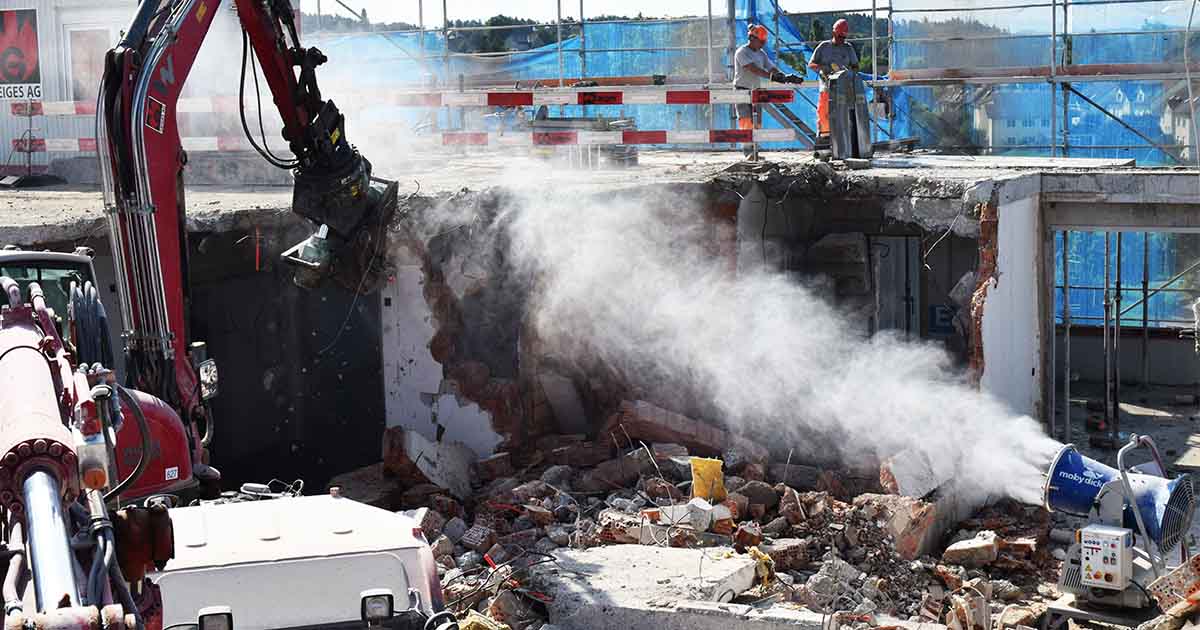Case Study: Effective Dust Suppression During the Demolition of a Hospital Bed Tower
Introduction
Dust emissions pose a significant challenge during demolition projects, especially in densely populated areas. An efficient dust control cannon is essential in such scenarios to protect residents, staff, and visitors from harmful fine dust particles. Recently, a construction company relied on the powerful MobyDick dust control systems during the dismantling of a 12-story hospital bed tower in a busy urban area. The demolition took place under challenging conditions, as the hospital remained operational, and regular helicopter traffic had to be considered. Reliable dust suppression was, therefore, a top priority.
Challenge
This demanding demolition project presented several challenges that necessitated the use of a highly flexible dust control system:
- Dust Control in a Sensitive Environment: The ongoing hospital operations made effective dust suppression crucial to protect patients, staff, and visitors from fine dust.
- Regular Helicopter Traffic: Air movements from the take-offs and landings of rescue helicopters increased the risk of uncontrolled dust spread.
- Limited Space: The urban location required a compact and flexibly deployable dust control cannon.
- Phased Demolition: The demolition work proceeded floor by floor, demanding an adaptable dust suppression solution.
- Ground-Level Dust Minimization: Minimizing dust during the crushing of demolition material was also essential.
To meet these challenges, the construction company deployed a combination of two MobyDick dust control cannons, each with specific strengths.
Application on Upper Floors – MobyDick Cannon Cart
For dust suppression on the upper floors, a MobyDick Cannon Cart was utilized.
- Optimal Throw Distance: With a range of about 30 meters, the cannon could bind dust directly at the source.
- Maximum Flexibility: Thanks to its compact design and lightweight, the dust control cannon could be flexibly positioned on the topmost floor.
- Effective Support for Demolition Excavators: As two demolition excavators worked down floor by floor, the Cannon Cart ensured continuous dust suppression.
Dust Minimization at Ground Level – MobyDick Cannon Single 50
Additionally, a MobyDick Cannon Single 50 was deployed at ground level.
- Targeted Dust Binding When Crushing Demolition Material: The unit significantly reduced dust emissions, minimizing environmental impact.
- Protection of Residents, Patients, and Staff: The effective dust control prevented health risks and maintained air quality.
Results and Benefits
- Effective Dust Binding Under Challenging Conditions: The combination of the Cannon Cart on the upper floors and the Cannon Single 50 at ground level enabled reliable dust suppression.
- Maximum Flexibility: The compact design of the Cannon Cart allowed the dust control cannon to be positioned directly at the demolition site, minimizing dust generation at the source.
- Protection of People and the Environment: Patients, hospital staff, visitors, and local residents were protected from harmful fine dust.
- Minimization of Dust Spread Despite Helicopter Operations: The targeted dust binding prevented dust stirred up by helicopter air movements from spreading further.
Conclusion
The successful dust suppression during the demolition of the hospital bed tower demonstrates that a targeted combination of MobyDick dust control cannons provides an efficient and flexible solution for challenging demolition tasks. With the Cannon Cart serving as a mobile, easily positionable solution on the upper floors and the Cannon Single 50 for dust binding at ground level, the dust burden was significantly reduced. This ensured a smooth construction process and protected the environment from harmful dust.

